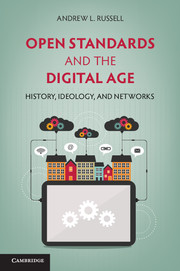Book contents
- Frontmatter
- Dedication
- Contents
- Tables and Figures
- Acknowledgments
- List of acronyms
- 1 Introduction
- 2 Ideological Origins of Open Standards I: Telegraph and Engineering Standards, 1860s–1900s
- 3 Ideological Origins of Open Standards II: American Standards, 1910s–1930s
- 4 Standardization and the Monopoly Bell System, 1880s–1930s
- 5 Critiques of Centralized Control, 1930s–1970s
- 6 International Standards for the Convergence of Computers and Communications, 1960s–1970s
- 7 Open Systems and the Limits of Democratic Design, 1970s–1980s
- 8 The Internet and the Advantages of Autocratic Design, 1970s–1990s
- 9 Conclusion
- Bibliography
- Index
- References
6 - International Standards for the Convergence of Computers and Communications, 1960s–1970s
Published online by Cambridge University Press: 05 June 2014
- Frontmatter
- Dedication
- Contents
- Tables and Figures
- Acknowledgments
- List of acronyms
- 1 Introduction
- 2 Ideological Origins of Open Standards I: Telegraph and Engineering Standards, 1860s–1900s
- 3 Ideological Origins of Open Standards II: American Standards, 1910s–1930s
- 4 Standardization and the Monopoly Bell System, 1880s–1930s
- 5 Critiques of Centralized Control, 1930s–1970s
- 6 International Standards for the Convergence of Computers and Communications, 1960s–1970s
- 7 Open Systems and the Limits of Democratic Design, 1970s–1980s
- 8 The Internet and the Advantages of Autocratic Design, 1970s–1990s
- 9 Conclusion
- Bibliography
- Index
- References
Summary
It is often argued that the computer industry lacks internal discipline as it exhibits a conspicuous inability to produce standards. Usual counter arguments are the youth of this industry, an extremely fast pace of evolution, and the dominance of one manufacturer. On the other hand the telecommunications industry has produced an impressive lot of standards over its long existence…. Both industries are now bound to become so intertwined that they can no longer look at each other from a respectful distance…. Orderly diversity is the only way to foster progress and keep a hand on one’s own destiny.
– Louis Pouzin, “Standards in Data Communications and Computer Networks,” 1975The formative technological innovations of the “open” digital age – electronic computers that exchange data through digital communication networks – did not, by themselves, drive the decentralization of authority in late-twentieth century global society. These technologies, the offspring of the stormy marriage of computing and communications, came into being as components of broader and more fundamental critiques of centralized control. Critiques came first; then came technical development, standardization, and, finally, social consequences.
In the United States and abroad, the computing industry was younger and more volatile than the communications industry. Telephone systems in all industrialized countries operated under the clear jurisdiction of national governments. The American arrangement, which featured the private administration of a national monopoly with the grudging approval of regulators, was abnormal (if not exceptional). American federal regulators in the 1950s, 1960s, and early 1970s used their authority to prevent AT&T from entering the computer business. These restrictions were motivated, in part, by the hope that competition would flourish and bring with it a new era of innovation that would fuel the continuation of American technological leadership.
- Type
- Chapter
- Information
- Open Standards and the Digital AgeHistory, Ideology, and Networks, pp. 161 - 196Publisher: Cambridge University PressPrint publication year: 2014



